|
Significance of the thrice blessed Day
Places of religious significance:
The four holy places of Buddhist
pilgrimage related to the life of the Buddha are Lumbini, Bodhgaya,
Kushinagar and Saranath(Samath,where the Buddha gave His first sermon)
in India.
Lumbini
|
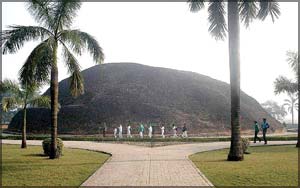
Ramabha Stupa (or Rambha Stupa, Adhana Stupa) in Kushinara (Kushi
nagar) in Uttar Pradesh, India was built over a portion of the
Buddha’s ashes by the ancient Malla people. It was erected on
the spot where the Buddha was cremated. |
|
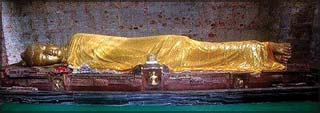
A 1500-year-old image of the Buddha as He attained Parinirvana. |
Lumbini is the birthplace of the Buddha and it’s located in
Kapilavastu, Nepal. Just before his birth in this world, the Bodhisatva
was the Lord of Tushita in the Deva realm. There he had resolved to be
reborn for the last time and show the attainment of Enlightenment to the
world.
He had made five investigations Kalaya (time), Deepaya (country),
Deshaya (land), Kulaya (cast), Mava (mother) and determined that this
southern continent was the most suitable place for this purpose.
When Emperor Ashoka visited Lumbini two centuries later, his advisor,
Sage Upagata, described, all these events to him, pointing out these
sites.
Emperor Ashoka then made many offerings here, and built an elaborate
stupa and erected a pillar surmounted by a horse capital. By the time
Hiouen Tsang saw it, lightning had already destroyed the pillar.
Nevertheless, even till the end of the last century, the inscription on
the ruin was sufficiently legible to clearly identify the site as
Lumbini, the birthplace of the Buddha.
Lumbini is on the foothills of the Himalaya. There are a number of
temples here including the Maya Devi Temple and the Puskarini or the
Holy Pond (where Buddha’s mother took her ritual dip prior to his birth
and where He too had His first bath) as well as the Kapilavastu palace.
In Buddha’s time, Lumbini was a park.
|
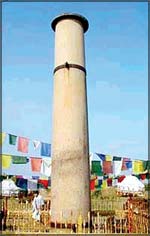
The Ashoka Pillar, a highly polished sand stone pillar(which
marks the place where Prince Siddhartha was born) also
commemorates the visit of Ashoka to Lumbini in the 3rd century
BC. |
|
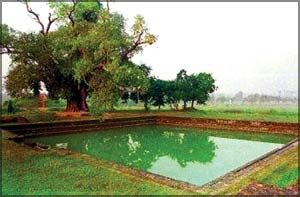
The Holy Pond in Lumbini |
Buddhagaya (Bodh Gaya)
The Bodhisattva, having renounced the luxurious life as Prince
Siddharatha, became Gauthama, the Ascetic. After leaving his palace, he
started walking in the southeastern direction from Kapilavastu and came
to Vaishali.
There, he listened briefly to the teaching of Alara Kaalama, but left
dissatisfied. Crossing the River Ganges, he once again entered the
Kingdom of Magadha and came to Rajgir, its capital, where he listened to
the yogis teaching of Uddakarama.
Again dissatisfied, he left the place, followed by five ascetics.
Along with them he came to the village of Uruvela, situated on the banks
of the Nairanjana River close to the palace now known as Buddhagaya (Bodh
Gaya).
There they engaged in a long, austere practice. For the first two
years, Gautama began reducing the number of meals and gradually he
reduced the quantity until at last he took only one grain of sesame
seed. He finally was reduced to a skeleton and He fainted. He later
realised that both extremes, luxury or extreme privation were useless.
Instead He chose the middle path.
Bodh gaya in India is where Siddhartha Gouthama became the Buddha as
He sat in meditation on the diamond seat under the Bodhi (Ficus
Religiosa) Tree. About 250 years after Buddha’s Enlightenment, Emperor
Ashoka who visited this site is believed to have founded the Mahabodhi
Temple and the Vajrasana - the Seat of Enlightenment.
|
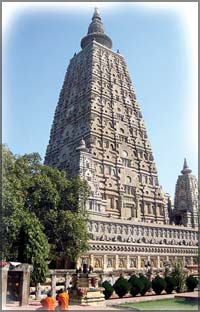
Mahabodhi temple in Buddhagaya. |
|
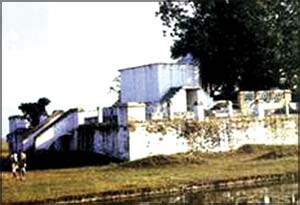
Maya Devi temple in Lumbini. |
|
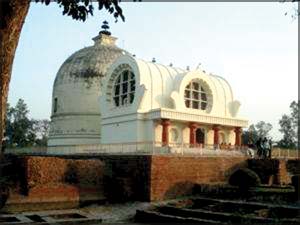
Parinirvana temple with the stupa. |
Buddhists believe this to be the navel of the Universe - the Vajra
Seat where past and future Buddhas achieve the ultimate state.
When Emperor Ashoka visited this place he set up a stone pillar with
an elephant capital just like in Lumbini, Samath and Kushinara. He also
sent a branch of the still living tree to Sri Lanka where it is
venerated as the Sri Maha Bodhi in Anuradhapura.This all happened around
250 BC.
Kushinara (Kushinagar)
Kushinara also known as Kusinagar or Kushinagar in the Indian State
of Uttar Pradesh is where Gautama Buddha attained Parinibbana in a Sal
forest. At the time of the Buddha, it was the capital of the Mallas, but
it was a small city and in fact it is said that Ananda was disappointed
that the Buddha chose it for His Parinibbana. But, by preaching the Maha
Sudassana Sutta, the Buddha had pointed out that in ancient times it had
been Kusvati, the Royal City of Maha Sudassana.
As the scene of His death, Kushinara became one of the four holy
places declared by the Buddha as fit to be places of pilgrimage for the
pious.
Today temples have been built by Indian, Chinese, Sri Lankan, Thai,
Burmese, South Korean, Tibetan and Japanese Buddhists, alongside the
ancient ruins of monasteries and stupas. The two places most visited in
Kushinagar are the Mahaparinirvana Stupa and the site of His cremation.
- Compiled by Asha Senevirathne
The life of the Buddha
Born into the royal family of a small kingdom called Kapilavastu on
the Indian-Nepalese border around the fifth century BC, Prince
Siddhartha had a cloistered upbringing according to the traditional
story, but, however, he was jolted out of complacency when he
encountered the harsh realities of life, such as old age, sickness and
death.
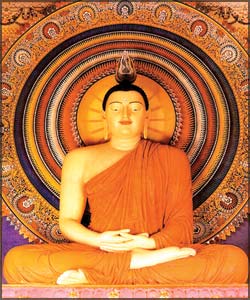 He
then left home in search of the real meaning of life. He practised
meditation under various teachers and then took to asceticism. He
then left home in search of the real meaning of life. He practised
meditation under various teachers and then took to asceticism.
The rigorous asceticism that he followed led him to the verge of
death. But, true understanding seemed as far away to him as eternity and
eventually, he abandoned this path. He then sat down beneath a peepal (bo)
tree and vowed that “flesh may wither, blood may dry up, but I shall not
rise from this spot until enlightenment has been won.” After forty days,
the Buddha finally attained Enlightenment.
Buddhists believe that He attained a state of being that goes beyond
anything else in this world. If normal experience is based on
conditions-upbringing, psychology, opinions, perceptions and so on,
Enlightenment is unconditional.
It was a state in which the Buddha gained insight into the deepest
workings of life and therefore, into the cause of human suffering, the
problem that had set Him on His spiritual quest in the first place.
During the remaining 45 years of His life, He travelled through much
of northern India, teaching the way to Enlightenment to others. The
teaching is known as the Buddha-dharma - ‘the teaching of the
Enlightened one’ in the East.
Travelling from place to place, the Buddha taught numerous disciples,
who gained Enlightenment in their own right. They, in turn, taught
others and in this way, an unbroken chain of teaching has continued,
right down to the present day.
The Buddha was not god and neither did He make any claim to divinity.
He was a human being who, through tremendous efforts, transformed
Himself. Buddhists see Him as an idol and a guide, who can lead them to
Enlightenment.
Finally at the age of 81 the Buddha arrived at the Kingdom of the
Malla’s, Kusinara (Kushinagar) where He attained Maha Parinirvana. He
asked His disciples whether there were any subjects among His teachings
that needed clarification. Finally when the Buddha attained Parinibbana,
the Pali cannon says, there was a strong earth tremor. |

